Puja of Deities is an easy way of abiding by achars (Conducts) set by Dharma to facilitate regular sadhana (Spiritual practice) of a worshipper. Puja of a Deity creates a center of devotion and bhav (Spiritual emotion) in the mind of the worshipper. It results in showering of grace by the Deity and makes the home environment more sattvik (Sattva-predominant). It also creates a sanskar (Impression on the subconscious mind) of Dharma on the future generation. Preparation for a puja is truly the foundation for the ritual of puja. It not only purifies the worshipper, but also equips him to imbibe Chaitanya (Divine consciousness) that is emitting from the puja; hence, the necessity of preparations.
Efforts made to imbibe the Chaitanya at the gross and subtle levels, so as to be able to perform spiritual practice in the form of puja, are termed as ‘preparations for puja’.
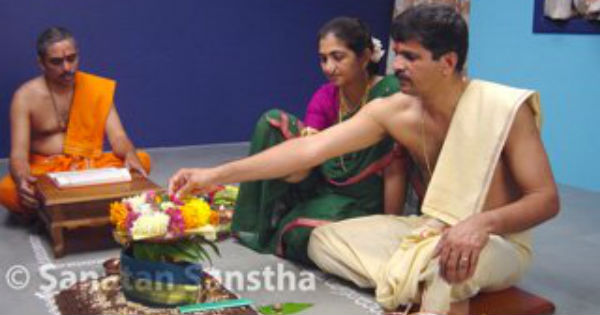
1. Meaning of the term ‘preparation’
In Hindu Dharma (meaning the religion), the term ‘preparation’ is used at three different levels – that of financial capability, good planning and purity. All the three levels are a part of preparations that precede the puja. These three help a worshipper obtain Shakti (Divine Energy) from the basic active Ichha-shakti (Energy of will), Kriya-shakti (Energy of action) and Dnyan-shakti (Energy of knowledge) respectively from the universe and prepare the worshipper to imbibe Chaitanya generated from the puja. Here, ‘preparedness’ is used in the context of the
manifestation of the impressions on the subconscious mind of the individual without any (mind disturbing) reaction. Only such an individual can receive Chaitanya generated from the puja in entirety.
2. Financial capability, good planning and
purity in relation to the mind and physical body
Getting thoughts about performing a puja is an indication of financial capability. Taking initiative and actively participating in puja is an indication of good planning. Physically performing the act with a lot of bhav, thereby satisfying various related constituents of the puja such as the Brahmaṇs (Priests) and receiving their blessings and blessings of Deities is an indication of purity.
Purity cleanses the subconscious mind and facilitates imbibing of knowledge. Good planning initiates activity, thereby awakening the creative energy; hence, it is a motivating factor in self-purification. Since the very purpose of financial capability is to lift the desire to the level of activity and initiate the task at the hands of the individual, the financial capability, effectively, acts as the medium for purification of the mind.
3. Effects on the mind
‘Preparations for puja’ are a triad of factors, namely ‘the motivator, the motivation and the one motivated’. The desire to perform puja acts as the motivator in an individual’s life. The resultant inspiration originating from within about the puja imparts the motivation. The word ‘motivated’ is generally used for referring to one charged or enthused with Chaitanya. When a puja is accomplished with the desired results completely, an individual gets motivated (or enthused) with Chaitanya. Puja performed with a lot of bhav confers onto the individual ‘inspirational mantra’ (meaning, reveals the secret) to leading a blissful life through generation of fresh Chaitanya.
4. Other effects
A. Generation of pleasant feeling at the physical level in the individual
The Chaitanya imparting touch of the sattvik substances used in puja with the body of the individual generates a pleasant feeling in the form of goose-pimples.
B. Purification of the premises and pleasantness in the surroundingenvironment
The sattvik pattern resulting from the specific arrangement of various substances used in the puja emits Chaitanya in the form of a fountain that purifies the premises and makes the surrounding environment pleasant.
C. Purification of the physical body of the individual
Wearing a sovale (A clean, washed, silk or cotton dhoti to be worn during the puja) and an uparṇe (A clean and pure silk cloth smaller than a dhoti, to be placed on the shoulder) and application of tilak (Mostly of vermillion or sandalwood paste) on the forehead are acts which equip the individual to imbibe sattvikta (Purity) in the physical body, thereby purifying it.
D. Arrival of Deities and blessings to the yajman (Host performing the puja)
A sankalp (Resolve) made ritualistically through the medium of a priest during the puja is responsible for the arrival of the Deities to the venue of the puja and for the showering of blessings on the yajman.
5. Benefits obtained from puja preparations
A. Preparing for puja by itself amounts to spiritual practice of the individual; hence, when the individual actually performs the puja, it is at a higher level spiritually and can imbibe greater amount of Chaitanya.
B. The Divine Principle emitted during puja can actually be imbibed by the worshipper even before the puja, that is, while preparing for the puja. Hence, the individual is able to avail the benefit of Chaitanya for a longer period.
C. Preparations for the puja increase the sattvikta and Atmashakti (Energy of the soul) in the individual. The increased sattvikta enables the individual to perform the puja of the Deity at the level of Atmashakti.
D. Since the act of preparations for puja is associated with sagun (Materialised)- bhav filled activity, it greatly enhances the bhav in the individual and enables it to perform the puja in a state of bhav that is sagun-nirgun (Non-materialised) in nature.
E. Since the acts in preparation for the puja are associated with activity (in the form of motion) and its stability, that is, associated with tranquility in the form of energy, the sushumna-naḍi (Please see Glossary) of the individual is activated immediately, and the individual is able to imbibe greater amount of Chaitanya.

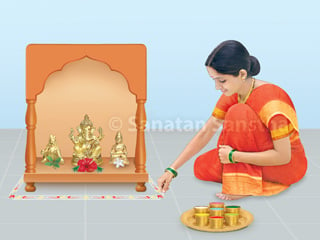 Importance of drawing Rangoli as a part of Puja preparations
Importance of drawing Rangoli as a part of Puja preparations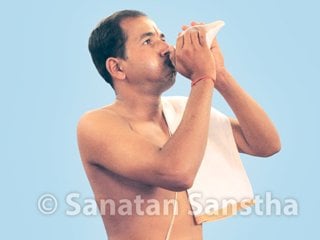 Sounding of a conch at the commencement of a puja
Sounding of a conch at the commencement of a puja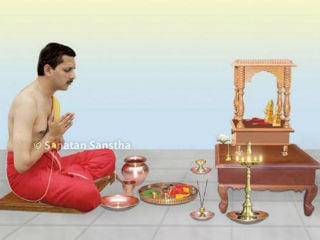 Why are kalash, conch, bell and lamp worshipped before puja ?
Why are kalash, conch, bell and lamp worshipped before puja ?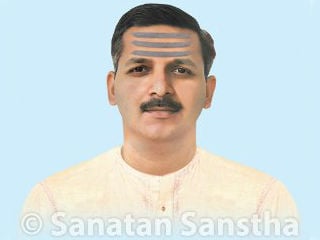 Importance of applying tilak or bhasma by the pujak while performing Puja
Importance of applying tilak or bhasma by the pujak while performing Puja Clothes to be worn by men and women while performing Puja
Clothes to be worn by men and women while performing Puja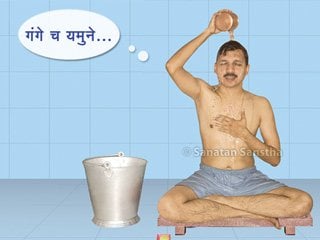 Why should we perform Puja immediately after a bath?
Why should we perform Puja immediately after a bath?